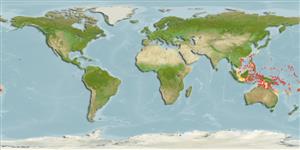Classification / Names
ชื่อสามัญ | ชื่อพ้อง | Catalog of Fishes(สกุล, ชนิด) | ITIS | CoL | WoRMS | Cloffa
>
Gobiiformes (Gobies) >
Gobiidae (Gobies) > Gobiinae
Etymology: Trimma: Greek, trimma, -atos = something crushed (Ref. 45335); nasa: Name derived from the English word 'nasal', a bar descending gtom the front of many medieval helmets to protect the nose, in allusion to the snout stripe; noun in apposition..
More on author: Winterbottom.
Environment: milieu / climate zone / depth range / distribution range
นิเวศวิทยา
เกี่ยวกับทะเล,น้ำเค็ม สัตว์น้ำหน้าดิน; ระดับความลึก 0 - 41 m (Ref. 55345), usually 0 - 20 m (Ref. 55345). Tropical
Western Pacific: Solomon Islands, Papua New Guinea, Indonesia, Vanuatu, Fiji, New Caledonia, Australia, the Philippines, and Palau.
ขนาด / น้ำหนัก / Age
Maturity: Lm ? range ? - ? cm
Max length : 2.3 cm SL เพศผู้/กระเทย; (Ref. 55345); 2.0 cm SL (female)
เงี่ยงครีบหลัง (รวม): 7; ก้านครีบอ่อนที่หาง (รวม): 8; เงี่ยงครีบก้น 1; ก้านครีบอ่อนที่ก้น: 7 - 9. Diagnosis: Predorsal scales and a bony interorbital about pupil diameter in width. Second dorsal spine elongated. Fifth pelvic fin ray branched dichotomously once and 50-60% of the fourth. Scales on cheek absent; one or two scales on the upper opercle; usually 4-5 rows of scales anterior to the pelvic fin base. A large spot over the hypural region of the caudal peduncle; a dark area along the side of the body caused by peritoneal pigmentation. In all specimens, but that from Palau and New Caledonia, there is a thin, dark stripe from the upper lip to the mid region of the interorbital when preserved (white in life), a broad rounded ridge on the snout and anterior interorbital region, and a nasal sac with a tubular anterior opening and a pore-like posterior opening with a raised rim (Ref. 55345); characterized further by having longitudinal scale series 23-24; predorsal scales 5-7; depth of body 4.3-4.6 in SL (Ref. 90102).
Cryptobenthic, epibenthic. Collected on drop-offs, either sloping or vertical with caves. Apparently tends to congregate in loose schools close to the shelter of caves and sea fans, to which they retreat when approached, and seem to be most abundant at about 20 meter depth range. Often form mixed schools with Trimma tevegae (Ref. 55345).
Life cycle and mating behavior
วัยเจริญพันธุ์ | การสืบพันธุ์ | การวางไข่ | เซลสืบพันธ์ของเพศเมีย(ไข่) | ความดกของไข่ | ตัวอ่อน
Winterbottom, R., 2005. Two new species of the Trimma tevegae species group from the Western Pacific (Percomorpha: Gobiidae). aqua, J. Ichthyol. Aquat. Biol. 10(1):29-38. (Ref. 55345)
IUCN Red List Status (Ref. 130435)
Threat to humans
Harmless
Human uses
ข้อมูลเพิ่มเติม
ชื่อสามัญชื่อพ้องกลไกการเผาผลาญพลังงานผู้ล่าการศึกษาเกี่ยวกับผลกระทบของสารประกอบทางเคมีที่เป็นอันตรายต่อสิ่งมีชีวิต ประชากร และสิ่งแวดล้อมการสืบพันธุ์วัยเจริญพันธุ์การวางไข่การรวมกลุ่มวางไข่ความดกของไข่เซลสืบพันธ์ของเพศเมีย(ไข่)Egg development
อ้างอิงการเพาะเลี้ยงสัตว์น้ำประวัติการเพาะเลี้ยงสัตว์น้ำสายพันธุ์พันธุศาสตร์ElectrophoresesอัตราพันธุกรรมโรคการแปรรูปNutrientsMass conversion
ผู้ร่วมมือรูปภาพหลายรูปStamps, Coins Misc.เสียงปลามีพิษ เช่น ปลาปักเป้าความเร็วรูปแบบการว่ายน้ำพื้นที่เหงือกOtolithsสมองวิสัยทัศน์
เครื่องมือ
Special reports
Download XML
แหล่งที่มาจากอินเตอร์เน็ต
Estimates based on models
Preferred temperature (Ref.
123201): 26.5 - 29.1, mean 28 °C (based on 330 cells).
Phylogenetic diversity index (Ref.
82804): PD
50 = 0.5000 [Uniqueness, from 0.5 = low to 2.0 = high].
Bayesian length-weight: a=0.01023 (0.00477 - 0.02194), b=3.02 (2.84 - 3.20), in cm total length, based on LWR estimates for this (Sub)family-body shape (Ref.
93245).
ความสามารถในการกลับคืนสู่ปกติ (Ref.
120179): ความสูง, เวลาต่ำสุดที่จะทำให้ประชากรเพิ่มขึ้นเป็น 2 เท่าใช้เวลาน้อยกว่า 15 เดือน (Preliminary K or Fecundity.).
Fishing Vulnerability (Ref.
59153): Low vulnerability (10 of 100).
